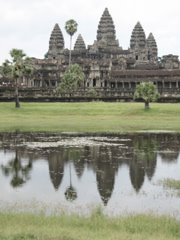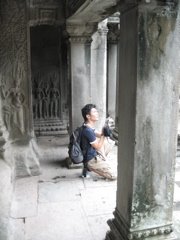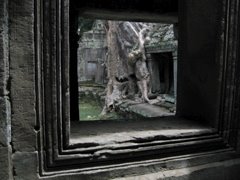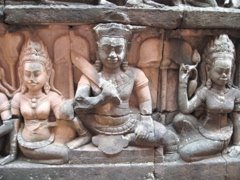Tuesday, August 08, 2006
Cambodia
The Kingdom of Cambodia is a country in Southeast Asia with a population of more than 13 million. Cambodia is the successor state of the once powerful Khmer Empire, which ruled most of the Indochinese Peninsula between the 11th and 14th centuries.
A citizen of Cambodia is usually identified as "Cambodian". "Khmer", which strictly only refers to ethnic Khmers, is also used. Most Cambodians are Theravada Buddhists of Khmer extraction, but the country also has a substantial number of predominantly Muslim Cham, as well as small hill tribes.
The country shares a border with Thailand to its west and north, with Laos to its northeast, and with Vietnam to its east. In the south it faces the Gulf of Thailand. The geography of Cambodia is dominated by the Mekong river (colloquial Khmer: Tonle Thom or "the great river") and the Tonle Sap ("the fresh water river"), an important source of fish.
Cambodia has a tropical climate - rainy, monsoon season from May to October and dry season from December to March. The terrain is mostly low, flat plains with mountains in the south-west and north. Natural resources include timber, gemstones, manganese, phosphates and hydropower potential.
Rate of literacy about 48 percent.
Average life expectancy 48.5 years (male 47 years, female 49.9 years) for the period 1985-90; some prevalent diseases are tuberculosis, malaria, infectious and parasitical illnesses; infant mortality 160 per thousand live births (1986); nonspecific gastro-enteritis accounts for disproportionate number of infant deaths; localized malnutrition and poor hygienic conditions exacerbate debility of population and susceptibility to illness. Total of 34 hospitals and 1,349 rural dispensaries nationwide; in countryside, network of primary care facilities being established with international help; hospitals planned or already established in provincial capitals, dispensaries at district (srok) level, first aid stations at village (khum) level; extension of health care greatly impeded by lack of trained personnel and inadequately developed infrastructure (especially clean water, and distribution or availability of medical supplies/equipment.)
Since independence, the official name of Cambodia has changed several times, following the troubled history of the country. The following names have been used in English and French since 1953.
● Kingdom of Cambodia/Royaume du Cambodge under the rule of the monarchy from 1953 through 1970;
● Khmer Republic/République Khmère (a calque of French Republic) under the Lon Nol led government from 1970 to 1975;
● Democratic Kampuchea/Kampuchea démocratique under the rule of the communist Khmer Rouge from 1975 to 1979;
● People's Republic of Kampuchea/République populaire du Kampuchea (a calque of People's Republic of China) under the rule of the Vietnamese-sponsored government from 1979 to 1989;
● State of Cambodia/État du Cambodge (a neutral name, while deciding whether to return to monarchy) under the rule of the United Nations transitional authority from 1989 to 1993;
● Kingdom of Cambodia/Royaume du Cambodge (return to the pre-1970's name) used after the restoration of the monarchy in 1993.
Despite recent progress, the Cambodian economy continues to suffer from the effects of decades of civil war, internal strife and rampant corruption. The per capita income is rapidly increasing, but is low compared with other countries in the region. Most rural households depend on agriculture and its related sub-sectors. Rice, fish, timber, garments and rubber are Cambodia's major exports, and the United States, Singapore, Japan, Thailand, Hong Kong, Indonesia and Malaysia are its major export partners.
The recovery of Cambodia's economy slowed dramatically in 1997-1998 due to the regional economic crisis, civil violence, and political infighting. Foreign investment and tourism also fell off drastically. Since then however, growth has been steady. In 1999, the first full year of peace in 30 years, progress was made on economic reforms and growth resumed at 5.0%. Despite severe flooding, GDP grew at 5.0% in 2000, 6.3% in 2001, and 5.2% in 2002. Tourism was Cambodia's fastest growing industry, with arrivals increasing from 219,000 in 1997 to 1,055,000 in 2004. During 2003 and 2004 the growth rate remained steady at 5.0%, while in 2004 inflation was at 1.7% and exports at $1.6 billion US dollars. As of 2005, GDP per Capita was $2,200 USD, which ranked it 178th (out of 233) countries.
The tourism industry is the country's second-greatest source of hard currency after the textile industry. More than 60% of visitor arrivals are to Angkor, and most of the remainder to Phnom Penh. Other tourist hotspots include Sihanoukville in the southeast which has several popular beaches, and the nearby area around Kampot including the Bokor Hill Station.

Angkor was the site of a series of capital cities of the Khmer empire for much of the period from the 9th century to the 15th century CE. Their ruins (13°24'N, 103°51'E) are located amid forests and farmland to the north of the Great Lake (Tonle Sap), near present day Siem Reap, Cambodia, and are a UNESCO World Heritage Site. The temples of the Angkor area number over one thousand, ranging in scale from nondescript piles of brick rubble scattered through rice fields to the magnificent Angkor Wat, said to be the world's largest single religious monument. Many of the temples at Angkor have been restored, and together they comprise the premier collection of examples of Khmer architecture. Visitor numbers approach one million annually.

Over a period of 300 years, between 900 and 1200 AD, the Khmer empire produced some of the world's most magnificent architectural masterpieces on the northern shore of the Tonle Sap, near the present town of Siem Reap. Most are concentrated in an area approximately 15 miles east to west and 5 miles north to south, although the Angkor Archaeological Park which administers the area includes sites as far away as Kbal Spean, about 30 miles to the north. Some 72 major temples or other buildings dot the area.

The principal temple, Angkor Wat, was built between 1112 and 1150 by Suryavarman II. With walls nearly one-half mile on each side, Angkor Wat portrays the Hindu cosmology with the central towers representing Mount Meru, home of the gods; the outer walls, the mountains enclosing the world; and the moat, the oceans beyond. The later capital of Angkor Thom, built after the Cham sack of 1177, has at its centre the Bayon. Construction of Angkor Thom coincided with a change from Hinduism to Mahayana Buddhism. Temples were altered to display images of the Buddha, and Angkor Wat briefly became a Buddhist shrine. A subsequent Hindu revival included a large-scale campaign of desecration of Buddhist images, before Theravada Buddhism became established from the 14th century.

During the 15th century, nearly all of Angkor was abandoned after Siamese attacks, except Angkor Wat, which remained a shrine for Buddhist pilgrims. The great city and temples remained largely cloaked by the forest until the late 19th century when French archaeologists began a long restoration process. From 1907 to 1970 restoration of Angkor was under the direction of the Ecole Française d'Extrême-Orient, which worked to clear away the forest, repair foundations, and install drains to protect the buildings from water damage. After the end of the civil war, work began again, and since 1993 it has been jointly co-ordinated by the French, Japanese and UNESCO through the International Co-ordinating Committee on the Safeguarding and Development of the Historic Site of Angkor (ICC), while Cambodian work is carried out by the Authority for the Protection and Management of Angkor and the Region of Siem Reap (APSARA), created in 1995. Some temples have been carefully taken apart stone by stone and reassembled on concrete foundations. Since the end of the civil war, international tourism to Angkor has increased, posing additional conservation problems but also financial assistance to the restoration projects.
Cambodia Information Center
Wikipedia: Cambodia
Country Studies: Cambodia
UNESCO World Heritage Centre
A citizen of Cambodia is usually identified as "Cambodian". "Khmer", which strictly only refers to ethnic Khmers, is also used. Most Cambodians are Theravada Buddhists of Khmer extraction, but the country also has a substantial number of predominantly Muslim Cham, as well as small hill tribes.
The country shares a border with Thailand to its west and north, with Laos to its northeast, and with Vietnam to its east. In the south it faces the Gulf of Thailand. The geography of Cambodia is dominated by the Mekong river (colloquial Khmer: Tonle Thom or "the great river") and the Tonle Sap ("the fresh water river"), an important source of fish.
Cambodia has a tropical climate - rainy, monsoon season from May to October and dry season from December to March. The terrain is mostly low, flat plains with mountains in the south-west and north. Natural resources include timber, gemstones, manganese, phosphates and hydropower potential.
Rate of literacy about 48 percent.
Average life expectancy 48.5 years (male 47 years, female 49.9 years) for the period 1985-90; some prevalent diseases are tuberculosis, malaria, infectious and parasitical illnesses; infant mortality 160 per thousand live births (1986); nonspecific gastro-enteritis accounts for disproportionate number of infant deaths; localized malnutrition and poor hygienic conditions exacerbate debility of population and susceptibility to illness. Total of 34 hospitals and 1,349 rural dispensaries nationwide; in countryside, network of primary care facilities being established with international help; hospitals planned or already established in provincial capitals, dispensaries at district (srok) level, first aid stations at village (khum) level; extension of health care greatly impeded by lack of trained personnel and inadequately developed infrastructure (especially clean water, and distribution or availability of medical supplies/equipment.)
Since independence, the official name of Cambodia has changed several times, following the troubled history of the country. The following names have been used in English and French since 1953.
● Kingdom of Cambodia/Royaume du Cambodge under the rule of the monarchy from 1953 through 1970;
● Khmer Republic/République Khmère (a calque of French Republic) under the Lon Nol led government from 1970 to 1975;
● Democratic Kampuchea/Kampuchea démocratique under the rule of the communist Khmer Rouge from 1975 to 1979;
● People's Republic of Kampuchea/République populaire du Kampuchea (a calque of People's Republic of China) under the rule of the Vietnamese-sponsored government from 1979 to 1989;
● State of Cambodia/État du Cambodge (a neutral name, while deciding whether to return to monarchy) under the rule of the United Nations transitional authority from 1989 to 1993;
● Kingdom of Cambodia/Royaume du Cambodge (return to the pre-1970's name) used after the restoration of the monarchy in 1993.
Despite recent progress, the Cambodian economy continues to suffer from the effects of decades of civil war, internal strife and rampant corruption. The per capita income is rapidly increasing, but is low compared with other countries in the region. Most rural households depend on agriculture and its related sub-sectors. Rice, fish, timber, garments and rubber are Cambodia's major exports, and the United States, Singapore, Japan, Thailand, Hong Kong, Indonesia and Malaysia are its major export partners.
The recovery of Cambodia's economy slowed dramatically in 1997-1998 due to the regional economic crisis, civil violence, and political infighting. Foreign investment and tourism also fell off drastically. Since then however, growth has been steady. In 1999, the first full year of peace in 30 years, progress was made on economic reforms and growth resumed at 5.0%. Despite severe flooding, GDP grew at 5.0% in 2000, 6.3% in 2001, and 5.2% in 2002. Tourism was Cambodia's fastest growing industry, with arrivals increasing from 219,000 in 1997 to 1,055,000 in 2004. During 2003 and 2004 the growth rate remained steady at 5.0%, while in 2004 inflation was at 1.7% and exports at $1.6 billion US dollars. As of 2005, GDP per Capita was $2,200 USD, which ranked it 178th (out of 233) countries.
The tourism industry is the country's second-greatest source of hard currency after the textile industry. More than 60% of visitor arrivals are to Angkor, and most of the remainder to Phnom Penh. Other tourist hotspots include Sihanoukville in the southeast which has several popular beaches, and the nearby area around Kampot including the Bokor Hill Station.

Angkor was the site of a series of capital cities of the Khmer empire for much of the period from the 9th century to the 15th century CE. Their ruins (13°24'N, 103°51'E) are located amid forests and farmland to the north of the Great Lake (Tonle Sap), near present day Siem Reap, Cambodia, and are a UNESCO World Heritage Site. The temples of the Angkor area number over one thousand, ranging in scale from nondescript piles of brick rubble scattered through rice fields to the magnificent Angkor Wat, said to be the world's largest single religious monument. Many of the temples at Angkor have been restored, and together they comprise the premier collection of examples of Khmer architecture. Visitor numbers approach one million annually.

Over a period of 300 years, between 900 and 1200 AD, the Khmer empire produced some of the world's most magnificent architectural masterpieces on the northern shore of the Tonle Sap, near the present town of Siem Reap. Most are concentrated in an area approximately 15 miles east to west and 5 miles north to south, although the Angkor Archaeological Park which administers the area includes sites as far away as Kbal Spean, about 30 miles to the north. Some 72 major temples or other buildings dot the area.

The principal temple, Angkor Wat, was built between 1112 and 1150 by Suryavarman II. With walls nearly one-half mile on each side, Angkor Wat portrays the Hindu cosmology with the central towers representing Mount Meru, home of the gods; the outer walls, the mountains enclosing the world; and the moat, the oceans beyond. The later capital of Angkor Thom, built after the Cham sack of 1177, has at its centre the Bayon. Construction of Angkor Thom coincided with a change from Hinduism to Mahayana Buddhism. Temples were altered to display images of the Buddha, and Angkor Wat briefly became a Buddhist shrine. A subsequent Hindu revival included a large-scale campaign of desecration of Buddhist images, before Theravada Buddhism became established from the 14th century.

During the 15th century, nearly all of Angkor was abandoned after Siamese attacks, except Angkor Wat, which remained a shrine for Buddhist pilgrims. The great city and temples remained largely cloaked by the forest until the late 19th century when French archaeologists began a long restoration process. From 1907 to 1970 restoration of Angkor was under the direction of the Ecole Française d'Extrême-Orient, which worked to clear away the forest, repair foundations, and install drains to protect the buildings from water damage. After the end of the civil war, work began again, and since 1993 it has been jointly co-ordinated by the French, Japanese and UNESCO through the International Co-ordinating Committee on the Safeguarding and Development of the Historic Site of Angkor (ICC), while Cambodian work is carried out by the Authority for the Protection and Management of Angkor and the Region of Siem Reap (APSARA), created in 1995. Some temples have been carefully taken apart stone by stone and reassembled on concrete foundations. Since the end of the civil war, international tourism to Angkor has increased, posing additional conservation problems but also financial assistance to the restoration projects.
Cambodia Information Center
Wikipedia: Cambodia
Country Studies: Cambodia
UNESCO World Heritage Centre
Labels: Holidays
Comments:
<< Home
what a great post gage! Very informative. I have never been here, or probably never go -- but the pictures fit beautifully.
:)
:)
just so I'm not misunderstood, the only reason I wouldn't go is cuz it is soooooo far away!
I luv 2 travel, but money just doesn't seem 2 B my thing!
:)
I luv 2 travel, but money just doesn't seem 2 B my thing!
:)
Yo, You know something, I think you will do very well in modules like History of South East Asia. Since I got a B, I think you definitely can get a A. Right? :=P
Anyway, glad that you enjoy our trip, and remember to study liao cos school has started...
Anyway, glad that you enjoy our trip, and remember to study liao cos school has started...
haha.. starbender!
yes. money is always an issue.
but nowadays travelling to asia is not too expensive
do consider travelling here!
guan heng.. no la.. read up many sites and condensed it. didn't write it myself :)
kester..
wait til i show you pictures.
those bricks are way too big!!
haha
and yes! i've got the expense breakdown for you
share with you with i see you :)
Post a Comment
yes. money is always an issue.
but nowadays travelling to asia is not too expensive
do consider travelling here!
guan heng.. no la.. read up many sites and condensed it. didn't write it myself :)
kester..
wait til i show you pictures.
those bricks are way too big!!
haha
and yes! i've got the expense breakdown for you
share with you with i see you :)
<< Home



